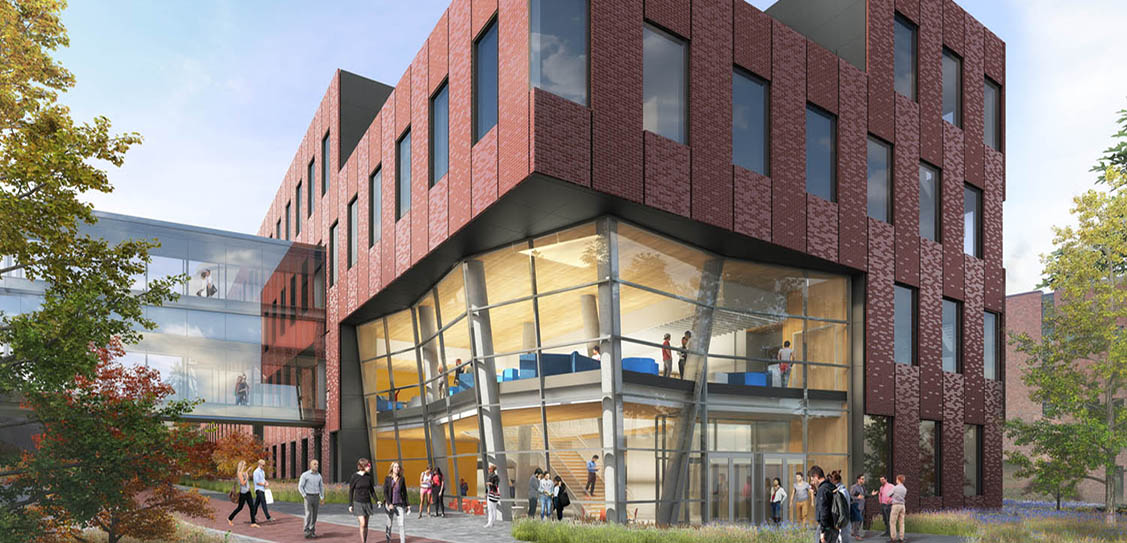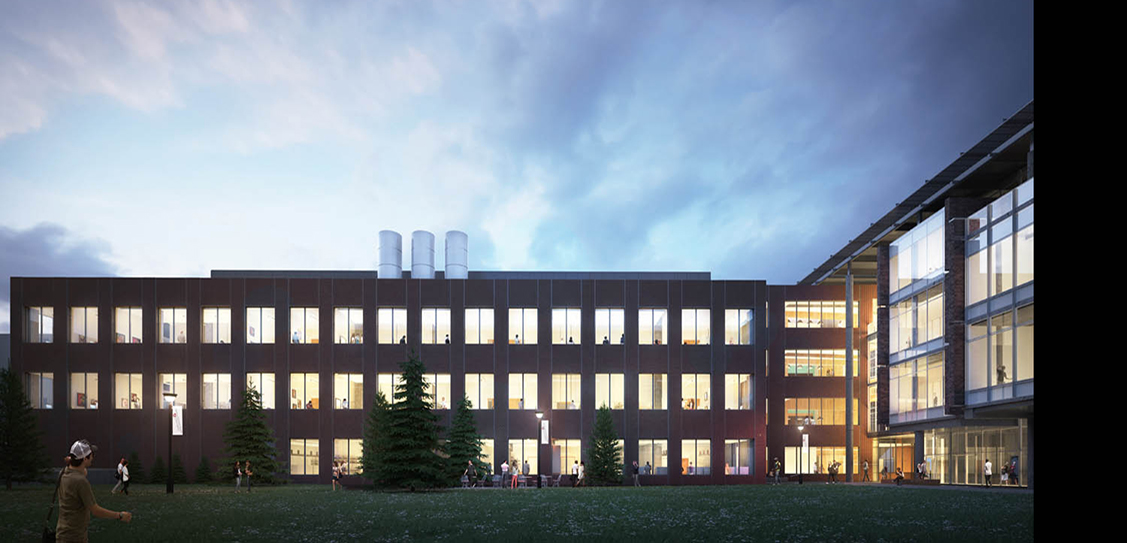LMN Architects celebrate the design and construction of two new science laboratories at Washington State University in Pullman, and Eastern Washington University in Cheney. Located at the centre of each development, the new laboratories have unique social spaces with welcoming environments for a discipline that has traditionally been on the periphery of each campus.
The Washington State University’s building is scheduled to be completed in October of 2020, and is intended to be the new centre for interdisciplinary research and is to be designed and constructed by the design/build team of Skanska and LMN Architects. The project provides new infrastructure for the Institute of Biological Chemistry, as well as laboratories that integrate faculty and students in plant biochemistry, pathology, horticulture, and crop and soil sciences into a single state-of-the-art facility.
Through our planning and design collaboration with Washington State University, we’ve envisioned a new state-of-the-art research facility that will both foster innovation in this critical sector and nurture a collaborative culture within the research campus.
Stephen Van Dyck, LMN Partner, AIA.
The new 82,000ft² building is the fourth to be completed within the master plan for the Research and Education Complex (REC) at WSU, originally developed by LMN Architects in 2005. The master plan envisioned a series of laboratory buildings alternately flanking a glazed spine element that serves as the connective tissue for the social and research life of the complex. The new building is positioned to the north of the Food Science and Human Nutrition Building and to the south of the Biotechnology and Life Sciences building, also designed by LMN Architects and completed in 2009. In its central location, the building also forms a prominent west-facing entry point to the completed complex.
The efficient plan arrangement of the L-shaped building allows it to fulfill the master plan while accommodating an existing utility tunnel to the south. The building’s cantilevered composition frames a new grand entry to the whole complex and features a two floor cantilever facing west towards Martin Stadium. The new landscaped approach creates a multifunctional public space for the university, celebrating arrival to the complex and fostering campus wide gatherings.
The new facility will be a social and interdisciplinary heart for the research complex. Designed for flexibility well into the future, the building hosts infrastructure for a variety of research needs beyond the College of Agriculture, Human and Natural Resource Sciences. Upon arrival, a welcoming four floor staircase encourages vertical circulation and provides important visual connections between floors. At every level, centralised social spaces link circulation elements with the REC’s central spine, designed to fuel spontaneous collaboration within the communal core.
The interior arrangement of laboratories is designed to support efficient and flexible research over time. The modular laboratories can be easily rearranged to respond to the changing needs of research throughout the building. To the north of the modular laboratories, offices for Principal Investigators are interspersed with open work areas for graduate researchers. To the south of the laboratories, a series of modular support spaces accommodate a variety of specialised research equipment within easy reach of the adjacent lab benches.
On the exterior, the building reimagines the red brick campus vernacular in a new architectural approach; a high performance precast concrete façade panel system is clad with a sculpted, red brick veneer. The panels integrate structure, insulation, weather barrier, interior and exterior finishes within a single prefabricated component, accelerating construction sequencing and enabling a bespoke composition of organically inspired brick surfacing. The resulting building form presents an abstract composition resulting in the integration of the building’s internal modular planning with the panelised façade components.
Together with Skanska and Washington State University, we have approached the delivery process as an effort in applied research. Our Progressive Design-Build team has pursued innovative design and construction methods throughout our process from day one, allowing us to explore new opportunities for architectural and material expression while maximising efficiencies at the same time.
Van Dyck.
The integrated façade system both enhances the speed of the construction schedule and transforms the architectural possibilities throughout the building. On the inside, the concrete panels are left exposed to become the finished surface in many of the building’s workspaces. On the exterior, the undulating brick pattern, made possible through bespoke, CNC driven formwork, casts shadows which animate the façade throughout the day in a dynamic play of light that is unique to the eastern Washington Palouse landscape.
The new Interdisciplinary Science Center for physics, chemistry, biology, and geology at Eastern Washington University places science prominently within the public life of the University. The 102,000ft² facility is connected to the existing Science Building Center by two enclosed pedestrian bridges, forming a single integrated facility between the two structures. The building design also completes the western edge of Arevalo Student Mall and to the south, it accommodates and amplifies a primary pedestrian corridor, connecting the central campus to the growing athletics precinct to the west. Along this pathway, the building and its bridges frame a significant new campus gateway moment that will reinforce the prominence of the Sciences at Eastern Washington University.
The Interdisciplinary Science Center is designed to enmesh the Sciences within the core of the Eastern campus. The project elevates the expectations of architecture and landscape to actively contribute to the pedagogical life of the building. Through our close working relationship with several faculty members during the design process, we were able to transform the project into a teaching tool itself.
S. Van Dyck, LMN Partner, AIA.
Inside the building, laboratory instrument exhibits and educational displays are integrated along its central corridor walls, creating an interactive educational environment and connecting laboratory and corridor in a dynamic exchange of filtered views. Outside the building, the landscape design was crafted in close collaboration between the design team and teaching faculty, and it features significant local geologic specimens along site walls and native plant species arrayed among the building’s various micro-climates.
The architectural composition presents a four level brick clad rectangular form with prominent voids at either end. Within each void, a crystalline glass wall marks major entries and social spaces.
The building is designed to be both symbolic and intuitive. The logic of the panelised brick enclosure gives way to the unexpected. These moments of punctuation and pause frame the spaces where people will come together, connecting the activity of the building within the campus beyond.
Van Dyck.
The dominant rectangular form of the building is clad with a panelised red brick façade system, alternately staggered in elevation to reveal a consistent rhythm of windows into the laboratory spaces within. The envelope system is detailed with a purity and simplicity to match the building’s composition, with black metal trim elements simplifying the joints between panels and windows. The planar brick panels are accentuated with a subtle mix of cascading glazed surfaces, animating the façade in a continual play of subtle reflection throughout the day.
The internal organisation of the building follows the linear movement through the site, with laboratories flanking either side of a generous central corridor on all floors. The building responds to the site topography through its internal circulation and features a prominent stair at the eastern entry that leads to the second level corridor and western entry beyond. A lecture hall at level one is carved into the sloping site and forms the terminus of that level in the hillside.
The three levels above feature a linear arrangement of laboratories, each with a corner display window that visually connects the teaching spaces to the social life of the building. Laboratories are tailored to the unique needs and special requirements of each department and are interconnected along the exterior edge of the building via a “ghost” corridor to adjacent prep rooms. A multipurpose gathering space on the fourth floor is accentuated with faceted glass walls facing south and east and features an adjacent terrace with views over the campus to the landscape and mountains beyond.
Sustainable strategies include low flow fume hoods and heat recovery pipes, rainwater harvesting, xeriscaping and inclusion of botanical and geological landscape elements that serve as teaching tools. The building is scheduled to be completed in the Fall and is targeting LEED Gold certification.
Each laboratory is a complex yet simple composition of private and public spaces that elevate the social experience. The buildings are in dialogue with the academic context, and each design is a highly ordered study in scale, materiality, transparency and natural light with various degrees of privacy for faculty and students.



